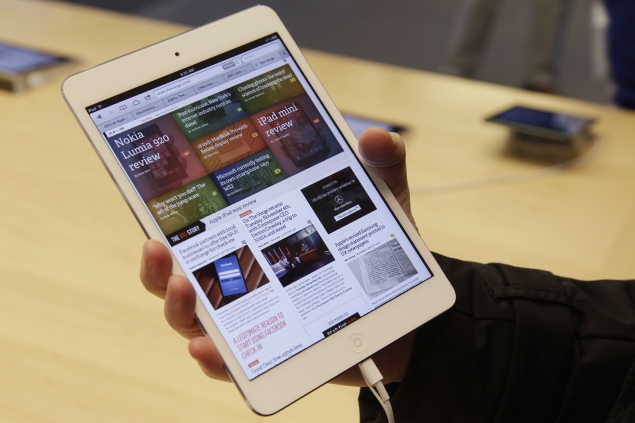I bet the iPad mini is going to be on a lot of wish lists this holiday
season. I also bet that for a lot of people, it's not going to be the
best choice. It's beautiful and light, but Apple made a big compromise
in the design, one that means that buyers should look closely at the
competition before deciding.Starting at $329, the iPad mini is the
cheapest iPad. The screen is a third smaller than the regular iPads, and
it sits in an exquisitely machined aluminum body. It weighs just 11
ounces half as much as a full-size iPad making it easier to hold in
one hand. It's just under 8 inches long and less than a third of an inch
thick, so it fits easily into a handbag.
The issue is the screen
quality. Apple has been on the forefront of a move toward sharper, more
colorful screens. It calls them "Retina" displays because the pixels
the little light-emitting squares that make up the screen are so small
that they blend together almost seamlessly in our eyes, removing the
impression that we're watching a grid of discrete elements.
The
iPad mini doesn't have a Retina screen. By the standards of last year,
it's a good screen, with the same number of pixels as the first iPad and
the iPad 2. The latest full-size iPad has four times as many pixels,
and it really shows. By comparison, the iPad mini's screen looks coarse.
It looks dull, too, because it doesn't have the same color-boosting
technology that the full-size model has.
This is not an entirely
fair comparison, as the full-size iPad starts at $499 and weighs twice
as much. The real issue is that this year, there are other tablets that
are cheaper than the iPad mini, weigh only slightly more and still have
better screens.
Amazon.com Inc.'s Kindle Fire HD costs $199 and
has about the same overall size as the mini. While the Kindle's screen
is somewhat smaller (leaving a bigger frame around the edges), it is
also sharper, with 30 percent more pixels than the mini. Colors are
slightly brighter, too.
Barnes & Noble Inc.'s Nook HD costs
$229 and has a screen that's even sharper than the Kindle HD's. It's got
65 percent more pixels than the iPad mini.
Why do tablets from two companies chiefly known as book stores beat Apple's latest for screen quality?
Sharper
screens are darker, requiring a more powerful backlight to appear
bright. That, in turn, would have forced an increase in the battery
size. That's the reason the first iPad with a Retina display was thicker
and heavier than the iPad 2. So to keep the iPad mini thin while
matching the 10-hour battery life of the bigger iPads, Apple had to
compromise on the display.
This can't last, though. By next year,
it will likely be even more obvious that Apple is seriously behind in
screen quality on its small tablet, and it will have to upgrade to a
Retina display somehow. That means this first-generation iPad mini will
look old pretty fast.
The display causes a few other problems,
too. One is that when you run iPhone apps on the mini, it uses the
coarsest version of the graphics for that app - the version designed for
iPhones up to the 2009 model, the 3GS. You can blow the app up to fill
more of the screen, but it looks pretty ugly. The full-size iPad uses
the higher-quality Retina graphics when running iPhone apps, and it
looks much better.
Some apps adapted for the iPad screen don't
display that well on the mini screen, either, because of the smaller
size. Buttons can be too small to hit accurately, bringing to mind Steve
Jobs' 2010 comments about smaller tablets. The late Apple founder was
of the vociferous opinion that the regular iPad was the smallest size
that was also friendly to use.
In some apps, text on the mini is
too small to be comfortably read - the section fronts in The New York
Times and The Wall Street Journal apps are examples of this.
Of
course, in some other respects, the iPad mini outdoes the Fire and the
Nook, so it isn't just the tablet for the buyer who needs the prettiest
and the thinnest. In particular, the Mini is a $329 entry ticket to the
wonderful world of iPad and iPhone apps. For quality and quantity, it
beats all the other app stores. (Oddly, there's an inverse relationship
between screen quality and app availability in this category the Nook
HD has the best screen and the fewest apps, while the second-best Kindle
Fire HD has middling access to apps.)
The Mini also has front-
and back-facing cameras, for taking still photos and video and for
videoconferencing. The Kindle Fire HD only has a front-facing camera for
videoconferencing. The Nook HD doesn't have a camera at all.
In
short, the iPad Mini is more versatile than the competition, and I'm
sure it will please a lot of people. But take a look at the competition
first, and figure that by next year, we'll see something from Apple that
looks a lot better.
About the iPad MiniThe base model of
the iPad mini costs $329 and comes with 16 gigabytes of storage. A 32 GB
model goes for $429 and 64 GB for $529. Soon, you'll be able to get
versions that can connect through cellular networks, not just Wi-Fi. Add
$130 to the price.
























































